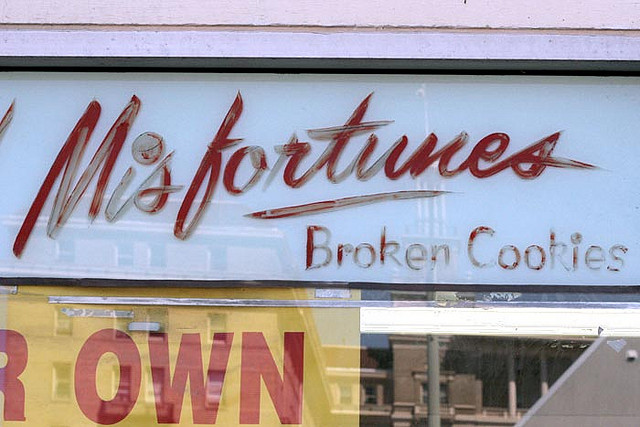Archive for the ‘How To’ Category
Don’t worry about the words, worry about the work.
 Doing anything for the first time is difficult. It goes with the territory. Instead of seeing the associated anxiety as unwanted and unpleasant, maybe you can use it as an indicator of importance. In that way, if you don’t feel anxious you know you’re doing what you’ve done before.
Doing anything for the first time is difficult. It goes with the territory. Instead of seeing the associated anxiety as unwanted and unpleasant, maybe you can use it as an indicator of importance. In that way, if you don’t feel anxious you know you’re doing what you’ve done before.
Innovation, as a word, has been over used (and misused). Some have used the word to repackage the same old thing and make it fresh again, but more commonly people doing good work attach the word innovation to their work when it’s not. Just because you improved something doesn’t mean it’s innovation. This is the confusion made by the lean and Six Sigma movements – continuous improvement is not innovation. The trouble with saying that out loud is people feel the distinction diminishes the importance of continuous improvement. Continuous improvement is no less important than innovation, and no more. You need them both – like shoes and socks. But problems arise when continuous improvement is done in the name of innovation and innovation is done at the expense of continuous improvement – in both cases it’s shoes, no socks.
Coming up with an acid test for innovation is challenging. Innovation is a know-it-when-you-see-it thing that’s difficult to describe in clear language. It’s situational, contextual and there’s no prescription. [One big failure mode with innovation is copying someone else’s best practice. With innovation, cutting and pasting one company’s recipe into another company’s context does not work.] But prescriptions and recipes aside, it can be important to know when it’s innovation and when it isn’t.
If the work creates the foundation that secures your company’s growth goals, don’t worry about what to call it, just do it. If that work doesn’t require something radically new and different, all-the-better. But you likely set growth goals that were achievable regardless of the work you did. But still, there’s no need to get hung up on the label you attach to the work. If the work helps you sell to customers you could not sell to before, call it what you will, but do more of it. If the work creates a whole new market, what you call it does not matter. Just hurry up and do it again.
If your CEO is worried about the long term survivability of your company, don’t fuss over labelling your work with the right word, do something different. If you have to lower your price to compete, don’t assign another name to the work, do different work. If your new product is the same as your old product, don’t argue if it’s the result of continuous improvement or discontinuous improvement. Just do something different next time.
Labelling your work with the right word is not the most important thing. It’s far more important to ask yourself – Five years from now, if the company is offering a similar product to a similar set of customers, what will it be like to work at the company? Said another way, arguing about who is doing innovation and who is not gets in the way of doing the work needed to keep the company solvent.
If the work scares you, that’s a good indication it’s meaningful. And meaningful is good. If it scares you because it may not work, you’re definitely trying something new. And that’s good. But it’s even better if the work scares you because it just might come to be. If that’s the case, your body recognizes the work could dismantle a foundational element of your business – it either invalidates your business model or displaces a fundamental technology. Regardless of the specifics, anxiety is a good surrogate for importance.
In some cases, it can be important what you call the work. But far more important than getting the name right is doing the right work. If you want to argue about something, argue if the work is meaningful. And once a decision is reached, act accordingly. And if you want to have a debate, debate the importance of the work, then do the important work as fast as you can.
Do the important work at the expense of arguing about the words.
To make a difference, add energy.
 If you want to make a difference, you’ve got to add energy. And the more you can add the bigger difference you can make.
If you want to make a difference, you’ve got to add energy. And the more you can add the bigger difference you can make.
Doing new is difficult and demands (and deserves) all the energy you can muster. Often it feels you’re the only one pushing in the right direction while everyone else is vehemently pushing the other way. But stay true and stand tall. This is not an indication things are going badly, this is a sign you’re doing meaningful work. It’s supposed to feel that way. If you’re exhausted, frustrated and sometimes a bit angry, you’re doing it right. If you have a healthy disrespect for the status quo, it’s supposed to feel that way.
Meaningful work has a long time constant and you’ve got to run these meaningful projects like marathons, uphill marathons. Every day you put in your 26 miles at a sustainable pace – no slower, but no faster. This is long, difficult work that doesn’t run by itself, you’ve got to push it like a sled. Every day you’ve got to push. To push every day like this takes a lot of physical strength, but it takes even more mental strength. You’ve got to stay focused on the critical path and push that sled every day. And you need to preserve enough mental energy to effectively ignore the non-critical path sleds. You’ve got to be able to decide which tasks you must get your whole body behind and which tasks you must discount. And you’ve got to preserve enough energy to believe in yourself.
Meaningful work cannot be accomplished by sprinting full speed five days a week. It’s a marathon, and you’ve got to work that way and train that way. Get your rest, get your exercise, eat right, spend time with friends and family, and put your soul into your work.
Choose work that is meaningful and add energy. Add it every day. Add it openly. Add it purposefully. Add it genuinely. Add energy like you’re an aircraft carrier and others will get pulled along by your wake. Add energy like you’re bulldozer and others will get out of your way. Add energy like you’re contagious and others will be infected.
Image credit – anton borzov
The Top Three Enemies of Innovation – Waiting, Waiting, Waiting
 All innovation projects take longer than expected and take more resources than expected. It’s time to change our expectations.
All innovation projects take longer than expected and take more resources than expected. It’s time to change our expectations.
With regard to time and resources, innovation’s biggest enemy is waiting. There. I said it.
There are books and articles that say innovation is too complex to do quickly, but complexity isn’t the culprit. It’s true there’s a lot of uncertainty with innovation, but, uncertainty isn’t the reason it takes as long as it does. Some blame an unhealthy culture for innovation’s long time constant, but that’s not exactly right. Yes, culture matters, but it matters for a very special reason. A culture intolerant of innovation causes a special type of waiting that, once eliminated, lets innovation to spool up to break-neck speeds.
Waiting? Really? Waiting is the secret? Waiting isn’t just the secret, it’s the top three secrets.
In a backward way, our incessant focus on productivity is the root cause for long wait times and, ultimately, the snail’s pace of innovation. Here’s how it goes. Innovation takes a long time so productivity and utilization are vital. (If they’re key for manufacturing productivity they must be key to innovation productivity, right?) Utilization of fixed assets – like prototype fabrication and low volume printed circuit board equipment – is monitored and maximized. The thinking goes – Let’s jam three more projects into the pipeline to get more out of our shared resources. The result is higher utilizations and skyrocketing queue times. It’s like company leaders don’t believe in queuing theory. Like with global warming, the theory is backed by data and you can’t dismiss queuing theory because it’s inconvenient.
One question: If over utilization of shared resources delays each prototype loop by two weeks (creates two weeks of incremental wait time) and you cycle through 10 prototype loops for each innovation project, how many weeks does it delay the innovation project? If you said 20 weeks you’re right, almost. It doesn’t delay just that one project; it delays all the projects that run through the shared resource by 20 weeks. Another question: How much is it worth to speed up all your innovation projects by 20 weeks?
In a second backward way, our incessant drive for productivity blinds us of the negative consequences of waiting. A prototype is created to determine viability of a new technology, and this learning is on the project’s critical path. (When the queue time delays the prototype loop by two weeks, the entire project slips two weeks.) Instead of working to reduce the cycle time of the prototype loop and advance the critical path, our productivity bias makes us work on non-critical path tasks to fill the time. It would be better to stop work altogether and help the company feel the pain of the unnecessarily bloated queue times, but we fill the time with non-critical path work to look busy. The result is activity without progress, and blindness to the reason for the schedule slip – waiting for the over utilized shared resource.
A company culture intolerant of uncertainty causes the third and most destructive flavor of waiting. Where productivity and over utilization reduce the speed of innovation, a culture intolerant of uncertainty stops innovation before it starts. The culture radiates negative energy throughout the labs and blocks all experiments where the results are uncertain. Blocking these experiments blocks the game-changing learning that comes with them, and, in that way, the culture create infinite wait time for the learning needed for innovation. If you don’t start innovation you can never finish. And if you fix this one, you can start.
To reduce wait time, it’s important to treat manufacturing and innovation differently. With manufacturing think efficiency and machine utilization, but with innovation think effectiveness and response time. With manufacturing it’s about following an established recipe in the most productive way; with innovation it’s about creating the new recipe. And that’s a big difference.
If you can learn to see waiting as the enemy of innovation, you can create a sustainable advantage and a sustainable company. It’s time to change expectations around waiting.
Image credit – Pulpolux !!!
Strategic Planning is Dead.
 Things are no longer predictable, and it’s time to start behaving that way.
Things are no longer predictable, and it’s time to start behaving that way.
In the olden days (the early 2000s) the pace of change was slow enough that for most the next big thing was the same old thing, just twisted and massaged to look like the next big thing. But that’s not the case today. Today’s pace is exponential, and it’s time to behave that way. The next big thing has yet to be imagined, but with unimaginable computing power, smart phones, sensors on everything and a couple billion new innovators joining the web, it should be available on Alibaba and Amazon a week from next Thursday. And in three weeks, you’ll be able to buy a 3D printer for $199 and go into business making the next big thing out of your garage. Or, you can grasp tightly onto your success and ride it into the ground.
To move things forward, the first thing to do is to blow up the strategic planning process and sweep the pieces into the trash bin of a bygone era. And, the next thing to do is make sure the scythe of continuous improvement is busy cutting waste out of the manufacturing process so it cannot be misapplied to the process of re-imagining the strategic planning process. (Contrary to believe, fundamental problems of ineffectiveness cannot be solved with waste reduction.)
First, the process must be renamed. I’m not sure what to call it, but I am sure it should not have “planning” in the name – the rate of change is too steep for planning. “Strategic adapting” is a better name, but the actual behavior is more akin to probe, sense, respond. The logical question then – what to probe?
[First, for the risk minimization community, probing is not looking back at the problems of the past and mitigating risks that no longer apply.]
Probing is forward looking, and it’s most valuable to probe (purposefully investigate) fertile territory. And the most fertile ground is defined by your success. Here’s why. Though the future cannot be predicted, what can be predicted is your most profitable business will attract the most attention from the billion, or so, new innovators looking to disrupt things. They will probe your business model and take it apart piece-by-piece, so that’s exactly what you must do. You must probe-sense-respond until you obsolete your best work. If that’s uncomfortable, it should be. What should be more uncomfortable is the certainty that your cash cow will be dismantled. If someone will do it, it might as well be you that does it on your own terms.
Over the next year the most important work you can do is to create the new technology that will cause your most profitable business to collapse under its own weight. It doesn’t matter what you call it – strategic planning, strategic adapting, securing the future profitability of the company – what matters is you do it.
Today’s biggest risk is our blindness to the immense risk of keeping things as they are. Everything changes, everything’s impermanent – especially the things that create huge profits. Your most profitable businesses are magnates to the iron filings of disruption. And it’s best to behave that way.
Image credit – woodleywonderworks
Compete with No One
 Today’s commercial environment is fierce. All companies have aggressive growth objectives that must be achieved at all costs. But there’s a problem – within any industry, when the growth goals are summed across competitors, there are simply too few customers to support everyone’s growth goals. Said another way, there are too many competitors trying to eat the same pie. In most industries it’s fierce hand-to-hand combat for single-point market share gains, and it’s a zero sum game – my gain comes at your loss. Companies surge against each other and bloody skirmishes break out over small slivers of the same pie.
Today’s commercial environment is fierce. All companies have aggressive growth objectives that must be achieved at all costs. But there’s a problem – within any industry, when the growth goals are summed across competitors, there are simply too few customers to support everyone’s growth goals. Said another way, there are too many competitors trying to eat the same pie. In most industries it’s fierce hand-to-hand combat for single-point market share gains, and it’s a zero sum game – my gain comes at your loss. Companies surge against each other and bloody skirmishes break out over small slivers of the same pie.
The apex of this glorious battle is reached when companies no longer have points of differentiation and resort to competing on price. This is akin to attrition warfare where heavy casualties are taken on both sides until the loser closes its doors and the winner emerges victorious and emaciated. This race to the bottom can only end one way – badly for everyone.
Trench warfare is no way for a company to succeed, and it’s time for a better way. Instead of competing head-to-head, it’s time to compete with no one.
To start, define the operating envelope (range of inputs and outputs) for all the products in the market of interest. Once defined, this operating envelope is off limits and the new product must operate outside the established design space. By definition, because the new product will operate with input conditions that no one else’s can and generate outputs no one else can, the product will compete with no one.
In a no-to-yes way, where everyone’s product says no, yours is reinvented to say yes. You sell to customers no one else can; you sell into applications no one else can; you sell functions no one else can. And in a wicked googly way, you say no to functions that no one else would dare. You define the boundary and operate outside it like no one else can.
Competing against no one is a great place to be – it’s as good as trench warfare is bad – but no one goes there. It’s straightforward to define the operating windows of products, and, once define it’s straightforward to get the engineers to design outside the window. The hard part is the market/customer part. For products that operate outside the conventional window, the sales figures are the lowest they can be (zero) and there are just as many customers (none). This generates extreme stress within the organization. The knee-jerk reaction is to assign the wrong root cause to the non-existent sales. The mistake – “No one sells products like that today, so there’s no market there.” The truth – “No one sells products like that today because no one on the planet makes a product like that today.”
Once that Gordian knot is unwound, it’s time for the marketing community to put their careers on the line. It’s time to push the organization toward the scary abyss of what could be very large new market, a market where the only competition would be no one. And this is the real hard part – balancing the risk of a non-existent market with the reward of a whole new market which you’d call your own.
If slugging it out with tenacious competitors is getting old, maybe it’s time to compete with no one. It’s a different battle with different rules. With the old slug-it-out war of attrition, there’s certainty in how things will go – it’s certain the herd will be thinned and it’s certain there’ll be heavy casualties on all fronts. With new compete-with-no-one there’s uncertainty at every turn, and excitement. It’s a conflict governed by flexibility, adaptability, maneuverability and rapid learning. Small teams work in a loosely coordinated way to test and probe through customer-technology learning loops using rough prototypes and good judgement.
It’s not practical to stop altogether with the traditional market share campaign – it pays the bills – but it is practical to make small bets on smart people who believe new markets are out there. If you’re lucky enough to have folks willing to put their careers on the line, competing with no one is a great way to create new markets and secure growth for future generations.
Image credit – mae noelle
Systematic Innovation
 Innovation is a journey, and it starts from where you are. With a systematic approach, the right information systems are in place and are continuously observed, decision makers use the information to continually orient their thinking to make better and faster decisions, actions are well executed, and outcomes of those actions are fed back into the observation system for the next round of orientation. With this method, the organization continually learns as it executes – its thinking is continually informed by its environment and the results of its actions.
Innovation is a journey, and it starts from where you are. With a systematic approach, the right information systems are in place and are continuously observed, decision makers use the information to continually orient their thinking to make better and faster decisions, actions are well executed, and outcomes of those actions are fed back into the observation system for the next round of orientation. With this method, the organization continually learns as it executes – its thinking is continually informed by its environment and the results of its actions.
To put one of these innovation systems in place, the first step is to define the group that will make the decisions. Let’s call them the Decision Group, or DG for short. (By the way, this is the same group that regularly orients itself with the information steams.) And the theme of the decisions is how to deploy the organization’s resources. The decision group (DG) should be diverse so it can see things from multiple perspectives.
The DG uses the company’s mission and growth objectives as their guiding principles to set growth goals for the innovation work, and those goals are clearly placed within the context of the company’s mission.
The first action is to orient the DG in the past. Resources are allocated to analyze the product launches over the past ten years and determine the lines of ideality (themes of goodness, from the customers’ perspective). These lines define the traditional ideality (traditional themes of goodness provided by your products) are then correlated with historical profitability by sales region to evaluate their importance. If new technology projects provide value along these traditional lines, the projects are continuous improvement projects and the objective is market share gain. If they provide extreme value along traditional lines, the projects are of the dis-continuous improvement flavor and their objective is to grow the market. If the technology projects provide value along different lines and will be sold to a different customer base, the projects could be disruptive and could create new markets.
The next step is to put in place externally focused information streams which are used for continuous observation and continual orientation. An example list includes: global and regional economic factors, mergers/acquisitions/partnerships, legal changes, regulatory changes, geopolitical issues, competitors’ stock price and quarterly updates, and their new products and patents. It’s important to format the output for easy visualization and to make collection automatic.
Then, internally focused information streams are put in place that capture results from the actions of the project team and deliver them, as inputs, for observation and orientation. Here’s an example list: experimental results (technology and market-centric), analytical results (technical and market), social media experiments, new concepts from ideation sessions (IBEs), invention disclosures, patent filings, acquisition results, product commercialization results and resulting profits. These information streams indicate the level of progress of the technology projects and are used with the external information streams to ground the DG’s orientation in the achievements of the projects.
All this infrastructure, process, and analysis is put in place to help the DG make good (and fast) decisions about how to allocate resources. To make good decisions, the group continually observes the information streams and continually orients themselves in the reality of the environment and status of the projects. At this high level, the group decides not how the project work is done, rather what projects are done. Because all projects share the same resource pool, new and existing projects are evaluated against each other. For ongoing work the DG’s choice is – stop, continue, or modify (more or less resources); and for new work it’s – start, wait, or never again talk about the project.
Once the resource decision is made and communicated to the project teams, the project teams (who have their own decision groups) are judged on how well the work is executed (defined by the observed results) and how quickly the work is done (defined by the time to deliver results to the observation center.)
This innovation system is different because it is a double learning loop. The first one is easy to see – results of the actions (e.g., experimental results) are fed back into the observation center so the DG can learn. The second loop is a bit more subtle and complex. Because the group continuously re-orients itself, it always observes information from a different perspective and always sees things differently. In that way, the same data, if observed at different times, would be analyzed and synthesized differently and the DG would make different decisions with the same data. That’s wild.
The pace of this double learning loop defines the pace of learning which governs the pace of innovation. When new information from the streams (internal and external) arrive automatically and without delay (and in a format that can be internalized quickly), the DG doesn’t have to request information and wait for it. When the DG makes the resource-project decisions it’s always oriented within the context of latest information, and they don’t have to wait to analyze and synthesize with each other. And when they’re all on the same page all the time, decisions don’t have to wait for consensus because it already has. And when the group has authority to allocate resources and chooses among well-defined projects with clear linkage to company profitability, decisions and actions happen quickly. All this leads to faster and better innovation.
There’s a hierarchical set of these double learning loops, and I’ve described only the one at the highest level. Each project is a double learning loop with its own group of deciders, information streams, observation centers, orientation work and actions. These lower level loops are guided by the mission of the company, goals of the innovation work, and the scope of their projects. And below project loops are lower-level loops that handle more specific work. The loops are fastest at the lowest levels and slowest at the highest, but they feed each other with information both up the hierarchy and down.
The beauty of this loop-based innovation system is its flexibility and adaptability. The external environment is always changing and so are the projects and the people running them. Innovation systems that employ tight command and control don’t work because they can’t keep up with the pace of change, both internally and externally. This system of double loops provides guidance for the teams and sufficient latitude and discretion so they can get the work done in the best way.
The most powerful element, however, is the almost “living” quality of the system. Over its life, through the work itself, the system learns and improves. There’s an organic, survival of the fittest feel to the system, an evolutionary pulse, that would make even Darwin proud.
But, really, it’s Colonel John Boyd who should be proud because he invented all this. And he called it the OODA loop. Here’s his story – Boyd: The Fighter Pilot Who Changed the Art of War.
Where possible, I have used Boyd’s words directly, and give him all the credit. Here is a list of his words: observe, orient, decide, act, analyze-synthesize, double loop, speed, organic, survival of the fittest, evolution.
Image attribution – U.S. Government [public domain]. by wikimedia commons.
The Lonely Chief Innovation Officer
 Chief Innovation Officer is a glorious title, and seems like the best job imaginable. Just imagine – every-day-all-day it’s: think good thoughts, imagine the future, and bring new things to life. Sounds wonderful, but more than anything, it’s a lonely slog.
Chief Innovation Officer is a glorious title, and seems like the best job imaginable. Just imagine – every-day-all-day it’s: think good thoughts, imagine the future, and bring new things to life. Sounds wonderful, but more than anything, it’s a lonely slog.
In theory it’s a great idea – help the company realize (and acknowledge) what it’s doing wrong (and has been for a long time now), take resources from powerful business units and move them to a fledgling business units that don’t yet sell anything, and do it without creating conflict. Sounds fun, doesn’t it?
Though there are several common problems with the role of Chief Innovation Officer (CIO), the most significant structural issue, by far, is the CIO has no direct control over how resources are allocated. Innovation creates products, services and business models that are novel, useful and successful. That means innovation starts with ideas and ends with commercialized products and services. And no getting around it, this work requires resources. The CIO is charged with making innovation come to be, yet authority to allocate resources is withheld. If you’re thinking about hiring a Chief Innovation Officer, here’s a rule to live by:
If resources are not moved to projects that generate novel ideas, convert those ideas into crazy prototypes and then into magical products that sell like hotcakes, even the best Chief Innovation Officer will be fired within two years.
Structurally, I think it’s best if the powerful business units (who control the resources) are charged with innovation and the CIO is charged with helping them. The CIO helps the business units create a forward-looking mindset, helps bring new thinking into the old equation, and provides subject matter expertise from outside the company. While this addresses the main structural issue, it does not address the loneliness.
The CIO’s view of what worked is diametrically opposed to those that made it happen. Where the business units want to do more of what worked, the CIO wants to dismantle the engine of success. Where the engineers that designed the last product want to do wring out more goodness out of the aging hulk that is your best product, the CIO wants to obsolete it. Where the business units see the tried-and-true business model as the recipe for success, the CIO sees it as a tired old cowpath leading to the same old dried up watering hole. If this sounds lonely, it’s because it is.
To combat this fundamental loneliness, the CIO needs to become part of a small group of trusted CIOs from non-competing companies. (NDAs required, of course.) The group provides its members much needed perspective, understanding and support. At the first meeting the CIO is comforted by the fact that loneliness is just part of the equation and, going forward, no longer takes it personally. Here are some example deliverables for the group.
Identify the person who can allocate resources and put together a plan to help that person have a big problem (no incentive compensation?) if results from the innovation work are not realized.
Make a list of the active, staffed technology projects and categorize them as: improving what already exists, no-to-yes (make a product/service do something it cannot), or yes-to-no (eliminate functionality to radically reduce the cost signature and create new markets).
For the active, staffed projects, define the market-customer-partner assumptions (market segment, sales volume, price, cost, distribution and sales models) and create a plan to validate (or invalidate) them.
To the person with the resources and the problem if the innovation work fizzles, present the portfolio of the active, staffed projects and its validated roll-up of net profit, and ask if portfolio meets the growth objectives for the company. If yes, help the business execute the projects and launch the products/services. If no, put a plan together to run Innovation Burst Events (IBEs) to come up with more creative ideas that will close the gap.
The burning question is – How to go about creating a CIO group from scratch? For that, you need to find the right impresario that can pull together a seemingly disparate group of highly talented CIOs, help them forge a trusting relationship and bring them the new thinking they need.
Finding someone like that may be the toughest thing of all.
Image credit – Giant Humanitarian Robot.
The Best Leading Indicator of Innovation
 Evaluation of innovation efforts is a hot topic. Sometimes it seems evaluating innovation is more important than innovation itself.
Evaluation of innovation efforts is a hot topic. Sometimes it seems evaluating innovation is more important than innovation itself.
Metrics, indicators, best practices, success stories – everyone is looking for the magical baseline data to compare to in order to define shortcomings and close them. But it’s largely a waste of time, because with innovation, it’s different every time. Look back two years – today’s technology is different, the market is different, and the people are different. If you look back and evaluate what went on and then use that learning to extrapolate what will happen in the future, well, that’s like driving a Formula One car around the track while looking in the rear view mirror. You will crash and you will get hurt because, by definition, with innovation, what you did in the past no longer applies, even to you.
Here’s a rule – when you look backward to steer your innovation work, you crash.
When you compare yourself to someone else’s innovation rearward looking innovation metrics, it’s worse. Their market was different than yours is, their company culture was different than yours is, their company mission and values were different. Their situation no longer applies to them and it’s less applicable to you, yet that’s what you’re doing when you compare yourself to a rearview mirror look at a best practice company. Crazy.
We’re fascinated with innovation metrics that are easy to measure, but we shouldn’t be. Anything that’s easy to measure cannot capture the nuance of innovation. For example, the number of innovation projects you ran over the last two years is meaningless. What’s meaningful is the incremental profit generated by the novel deliverables of the work and your level of happiness with the incremental profit. Number of issued patents is also meaningless. What’s meaningful is the incremental profit created by the novel goodness of the patented technology and your level of happiness with it. Number of people that worked on innovation projects or the money spent – meaningless. Meaningful – incremental profit generated by the novel elements of the work divided by the people (or cost) that created the novel elements and your level of happiness with it.
Things are a bit better with forward looking metrics – or leading indicators – but not much. Again, our fascination with things that are easy to measure kicks us in the shins. Number of patent applications, number of people working on projects, number of fully staffed technology projects, monthly spend on R&D – all of these are easily measured but are poor predictors innovation results. What if the patented technology is not valued by the customer? What if the people working on projects are working on projects that result in products that don’t sell? What if the fully staffed projects create new technologies for new markets that never come to be? What if your monthly spend is spent on projects that miss the mark?
To me, the only meaningful leading indicator for innovation is a deep understanding of your active technology projects. What must the technology do so the new market will buy it? How do you know that? Can you quantify that goodness in a quantifiable way? Will you know when that goodness has been achieved? In what region will the product be sold? What is the cost target, profit margin and the new customers’ ability to pay? What are the results of the small experiments where the team tested the non-functional prototypes and their price points in the new market? What does the curve look like for price point versus sales volume? What is your level of happiness with all this?
We have an unhealthy fascination with innovation metrics that are easy to measure. Instead of a sea of metrics that are easy to measure, we need nuanced leading indicators that are meaningful. And I cannot give you a list of meaningful leading indicators, because each company has a unique list which is defined by its growth objectives, company culture and values, business models, and competition. And I cannot give you threshold limits for any of them because only you can define that. The leading indicators and their threshold values are context-specific – only you can choose them and only you can judge what levels make you happy. Innovation is difficult because it demands judgment, and no metrics or leading indicators can take judgment out of the equation.
Creativity creates things that are novel and useful while innovation creates things that are novel, useful and successful. Dig into the details of your active technology projects and understand them from a customer-market perspective, because success comes only when customers buy your new products.
Image credit – coloneljohnbritt
Constructive Conflict
 Innovation starts with different, and when you propose something that’s different from the recipe responsible for success, innovation becomes the enemy of success. And because innovation and different are always joined at the hip, the conflict between success and innovation is always part of the equation. Nothing good can come from pretending the conflict does not exist, and it’s impossible to circumvent. The only way to deal with the conflict is to push through it.
Innovation starts with different, and when you propose something that’s different from the recipe responsible for success, innovation becomes the enemy of success. And because innovation and different are always joined at the hip, the conflict between success and innovation is always part of the equation. Nothing good can come from pretending the conflict does not exist, and it’s impossible to circumvent. The only way to deal with the conflict is to push through it.
Emotional energy is the forcing function that pushes through conflict, and the only people that can generate it are the people doing the work. As a leader, your job is to create and harness this invisible power, and for that, you need mechanisms.
To start, you must map innovation to “different”. The first trick is to ask for ideas that are different. Where brainstorming asks for quantity, firmly and formally discredit it and ask for ideas that are different. And the more different, the better. Jeffrey Baumgartner has it right with his Anticonventional Thinking (ACT) methodology where he pushes even further and asks for ideas that are anti-conventional.
The intent is to create emotional energy, and to do that there’s nothing better than telling the innovation team their ideas are far too conventional. When you dismiss their best ideas because they’re not different enough, you provide clear contrast between the ideas they created and the ones you want. And this contrast creates internal conflict between their best thinking and the thinking you want. This internal conflict generates the magical emotional energy needed to push through the conflict between innovation and success. In that way, you create intrinsic conflict to overpower the extrinsic conflict.
Because innovation is powered by emotional energy, conflict is the right word. Yes, it feels too strong and connotes quarrel and combat, but it’s the right word because it captures the much needed energy and intensity around the work. Just as when “opportunity” is used in place of “problem” and the urgency, importance, and emotion of the situation wanes, emotional energy is squandered when other words are used in place of “conflict”.
And it’s also the right word when it comes to solutions. Anti-conventional ideas demand anti-conventional solutions, both of which are powered by emotional energy. In the case of solutions, though, the emotional energy around “conflict” is used to overcome intellectual inertia.
Solving problems won’t get you mind-bending solutions, but breaking conflicts will. The idea is to use mechanisms and language to move from solving problems to breaking conflicts. Solving problems is regular work done as a matter of course and regular work creates regular solutions. But with innovation, regular solutions won’t cut it. We need irregular solutions that break from the worn tracks of predictable thinking. And do to this, all convention must be stripped away and all attachments broken to see and think differently. And, to jolt people out of their comfort zone, contrast must be clearly defined and purposefully amplified.
The best method I know to break intellectual inertia is ARIZ and algorithmic method for innovative solutions built on the foundation of TRIZ. With ARIZ, a functional model of the system is created using verb-noun pairs with the constraint that no industry jargon can be used. (Jargon links the mind to traditional thinking.) Then, for clarity, the functional model is then reduced to a conflict between two system elements and defined in time and place (the conflict domain.) The conflict is then made generic to create further distance from the familiar. From there the conflict is purposefully amplified to create a situation where one of the conflicting elements must be in two states at the same time (conflicting states) – hot and cold; large and small; stiff and flexible. The conflicting states make it impossible to rely on preexisting solutions (familiar thinking.) Though this short description of ARIZ doesn’t do it justice, it does make clear ARIZ’s intention – to use conflicts to break intellectual inertia.
Innovation butts heads and creates conflict with almost everything, but it’s not destructive conflict. Innovation has the best intentions and wants only to create constructive conflict that leads to continued success. Innovation knows your tired business model is almost out of gas and desperately wants to create its replacement, but it knows your successful business model and its tried-and-true thinking are deeply rooted in the organization. And innovation knows the roots are grounded in emotion and it’s not about pruning it’s about emotional uprooting.
Conflict is a powerful word, but the right word. Use the ACT mechanism to ask for ideas that constructively conflict with your success and use the ARIZ mechanism to ask for solutions that constructively conflict with your best thinking.
With innovation there is always conflict. You might as well make it constructive conflict and pull your organization into the future kicking and screaming.
Image credit – Kevin Thai
Innovation Fortune Cookies
 If they made innovation fortune cookies, here’s what would be inside:
If they made innovation fortune cookies, here’s what would be inside:
If you know how it will turn out, you waited too long.
Whether you like it or not, when you start something new uncertainty carries the day.
Don’t define the idealized future state, advance the current state along its lines of evolutionary potential.
Try new things then do more of what worked and less of what didn’t.
Without starting, you never start. Starting is the most important part
Perfection is the enemy of progress, so are experts.
Disruption is the domain of the ignorant and the scared.
Innovation is 90% people and the other half technology.
The best training solves a tough problem with new tools and processes, and the training comes along for the ride.
The only thing slower than going too slowly is going too quickly.
An innovation best practice – have no best practices.
Decisions are always made with judgment, even the good ones.
image credit – Gwen Harlow
Battle Success With No-To-Yes
 Everyone says they want innovation, but they don’t – they want the results of innovation.
Everyone says they want innovation, but they don’t – they want the results of innovation.
Innovation is about bringing to life things that are novel, useful and successful. Novel and useful are nice, but successful pays the bills. Novel means new, and new means fear; useful means customers must find value in the newness we create, and that’s scary. No one likes fear, and, if possible, we’d skip novel and useful altogether, but we cannot. Success isn’t a thing in itself, success is a result of something, and that something is novelty and usefulness.
Companies want success and they want it with as little work and risk as possible, and they do that with a focus on efficiency – do more with less and stock price increases. With efficiency it’s all about getting more out of what you have – don’t buy new machines or tools, get more out of what you have. And to reduce risk it’s all about reducing newness – do more of what you did, and do it more efficiently. We’ve unnaturally mapped success with the same old tricks done in the same old way to do more of the same. And that’s a problem because, eventually, sameness runs out of gas.
Innovation starts with different, but past tense success locks us into future tense sameness. And that’s the rub with success – success breeds sameness and sameness blocks innovation. It’s a strange duality – success is the carrot for innovation and also its deterrent. To manage this strange duality, don’t limit success; limit how much it limits you.
The key to busting out of the shackles of your success is doing more things that are different, and the best way to do that is with no-to-yes.
If your product can’t do something then you change it so it can, that’s no-to-yes. By definition, no-to-yes creates novelty, creates new design space and provides the means to enter (or create) new markets. Here’s how to do it.
Scan all the products in your industry and identify the product that can operate with the smallest inputs. (For example, the cell phone that can run on the smallest battery.) Below this input level there are no products that can function – you’ve identified green field design space which you can have all to yourself. Now, use the industry-low input to create a design constraint. To do this, divide the input by two – this is the no-to-yes threshold. Before you do you the work, your product cannot operate with this small input (no), but after your hard work, it can (yes). By definition the new product will be novel.
Do the same thing for outputs. Scan all the products in your industry to find the smallest output. (For example, the automobile with the smallest engine.) Divide the output by two and this is your no-to-yes threshold. Before you design the new car it does not have an engine smaller than the threshold (no), and after the hard work, it does (yes). By definition, the new car will be novel.
A strange thing happens when inputs and outputs are reduced – it becomes clear existing technologies don’t cut it, and new, smaller, lower cost technologies become viable. The no-to-yes threshold (the constraint) breaks the shackles of success and guides thinking in a new directions.
Once the prototypes are built, the work shifts to finding a market the novel concept can satisfy. The good news is you’re armed with prototypes that do things nothing else can do, and the bad news is your existing customers won’t like the prototypes so you’ll have to seek out new customers. (And, really, that’s not so bad because those new customers are the early adopters of the new market you just created.)
No-to-yes thinking is powerful, and though I described how it’s used with products, it’s equally powerful for services, business models and systems.
If you want innovation (and its results), use no-to-yes thinking to find the limits and work outside them.
 Mike Shipulski
Mike Shipulski